September 12th, 2010 · 3 Comments
I’ve been fascinated by the effects of alcohol ever since I read The Strange Case of Dr. Jekyll and Mr. Hyde in my freshman year, the same time I was introduced to college drinking social norms. By day students go to class and make self-aware, well thought out comments and criticisms of society, and by night drink and do all manner of scandalous things to gossip about in the morning (obviously not everyone, but a sizeable portion). We’ve been talk about the British social dis-ease, but I wonder if American social customs are really all that different.
Kate Fox notes that our expectations of alcohol’s effects are cultural rather than purely biological (261). England is known for its aggressive drunks and that expectation, and possibly a little national pride, is a self fulfilling prophecy. As the drunk insane asylum manager from everyone’s favorite show, Bedlam, says as he stumbles around the stage, “We’re English. It’s what we do” to which the audience responded with a proud cheer. For whatever reason, boisterous drunkness is a major source of identity for England, even if it’s also a symptom of the inability to socialize without a lubricant to put you in a liminal state. As a result, while Latin American countries associate alcohol with more peaceful states, England gets bars in Covent Square Garden that forbid the wearing of football colors to prevent bar fights.
I’ve tried to visit a few different types of pubs, and I’ve found so far that no matter the atmosphere, the clientele, or even the level of drunkenness, when it comes to alcohol the Brits are not the friendliest bunch (You see what I did there? Understatement. I’m so assimilated). I’ve managed to get over the occasional obvious refusals of service when pubs close at an oddly specific time if they see a group of five Americans coming toward them. The slightly more expensive pubs I’ve gone to have not been as bad. I usually just get a server who refuses to make any form of polite small talk or eye contact with me, unless he is joining in the group glare that I often receive from everyone in the room when I speak, stand in the wrong place, or exist. The younger, louder pubs were pretty nice because fewer people could hear my accent and it was too loud for me to hear angry throat clears. Unfortunately, the minute I got outside, a few drunk men took it upon themselves to fix that by yelling obscenities and telling me to go back to America (In their defense, I think I might have offended them when I was praising the benefits of Razor Scooters as they walked past. Hot button issue).
During the day, besides the occasional angry glare when I use my 6 inch voice instead of my 4 inch voice in the library, people have been generally friendly, which leads me to believe that Fox is right about the British extremes in behavior. They’re excessively mild and polite (Jekyll) until they drink a potion that makes them grow fur on their hands and have a strong desire to beat me to death with a cane.
Tags: 2010 Jesse
September 15th, 2009 · 1 Comment
Today I visited the British Museum. Yes, I know, I am probably the LAST person to go there. But to be honest, I was really putting it off. Now that may seem strange to you, since if you’ve been keeping up with my blog, you know I ADORE museums. Yet, for some reason the idea of museum that I could spend my entire life trying to see the entire collection of, just didn’t get me going. I was told it was a history museum, told it was vast, told it was cool. But still. I’m not a history museum fan and I guess the past month has really museumed me out. With all that being said, I LOVED it.
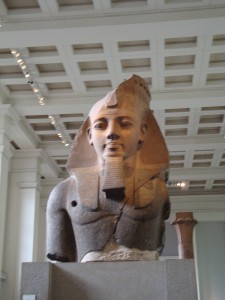
Egypt Wing of museum
And I loved it for several different reasons. The first and less detailed reason was what I faced when I first ventured into a gallery. It was the Egypt wing. I am not a fan. I don’t dislike all the mummy cases and pharaoh busts, they just aren’t really my thing. But back in Brooklyn, at the Brooklyn Museum of Art, the museum that I have been going to since my stroller days, the first place where I took an art class, and where I spent my summer interning, there is a HUGE Egypt wing. And suddenly, there I was, middle of the British Museum Egypt wing, in London, in England, in a FOREIGN COUNTRY, and home, all at once. I didn’t stay in the wing long, but the small boost of Brooklyn love I got from the wing was just what I needed before we embark on our new adventure to Norwich.
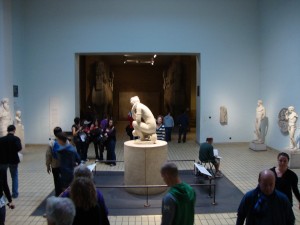
The Greece Wing of the British Museum
Another reason I loved it was on the pure artistic level. As a museum lover and art minor, walking into the museum facing the Greek statues and really analyzing them art historically was so amazing. I really took my time looking a few pieces rather than trying to see everything in the overwhelming collection. I noted the realism in the Hellenistic section of the Greece wing. I got right up close to the statues and looked at the small details, the way the flesh was rolled where the body curved, or the controposto (weight distribution), or the way the head resting on the elbow really had the right weight. Even the way the lighting on the marble gave it a warm yellow hue, almost like the warmth of skin and the human body, making the figures see that much more alive and real. Often I found myself inching closer and closer to a figure wanting to touch the marble, wanting to feel the coolness of it just to remind myself it was not warm flesh.
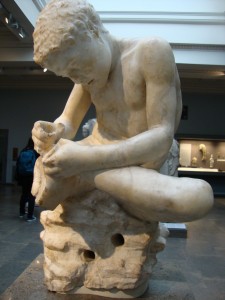
There was on statue of a small boy, Marble statues of a boy, the so-called ‘spinaro.’ This one was one of the most touching. The boy was pulling a torn out of his foot. And the expression on his face was just right, to show a little boy’s concentration and fascination. Having a little brother myself may have biased me towards this sculpture over others, and maybe it was just another thing in the museum that made me feel at home. But really, even the way to boy was crouched over suited the narrative of the piece.
On another note, the British Museum has so many connections to our course here in London. Aside from its fame Reading Room that relates to the literary history of this area, there is always the basic collection as a representation of all the different communities and cultures present. With a wing from almost every continent, the British Museum has very few things that could be considered wholly “British.” But at the same time, isn’t that really what we have learned here this past month, that NOTHING really is WHOLLY British? I think it is. In essence, the British museum encompasses our whole class and our final conclusion that there is no British identity. That there are only many pieces from many different elements of people’s lives that use to help with their personal identification.
Tags: Megan · Museums
September 14th, 2009 · 1 Comment
From what I heard from other group members, I wasn’t quite sure what to expect about the Victoria and Albert Museum. Being situated right next to the Natural History Museum, I wished I could skip the Victoria and Albert and go straight there. Nonetheless, once I entered the V&A, I knew I would not be disappointed. Sadly, I did not get to see every exhibit, but I saw enough to realize how amazing the V&A is. The one exhibit which I really liked was the medieval section. Despite the fact that the other half of it was closed due to renovations and preparation for an updated exhibit, there was no disappointment to be found with the half that was open.
The Cast Courts was perhaps one of the most amazing exhibits I have seen in a museum in London. Though not the originals, the casts in this exhibit are truly marvelous. Trajan’s Column stunned me once I entered the room. Its massive size and detailed inscription spoke volumes about the glory and power that was once the Roman Empire. I had the same feelings of glory and power when I saw the cast of Perseus with the severed head of Medusa. Though nowhere near in size to Trajan’s Column, the cast still gave off an aura of greatness. These feelings were not just with Roman casts. The altarpiece of the annunciation and passion of Christ was spectacular. Its intricate detail and beauty was beyond comparison; it was my favorite altarpiece out of all of them in the V&A. Almost rivaling Trajan’s Column was the Portico de la Gloria. Though in Spain, this cast was simply beautiful. Built to honor God, the structure is also a monument to what Man is capable of creating.
One thing I think some people had a problem with the V&A was that there was just a bunch of differing exhibits together in the same museum; you could go from Medieval Europe to Japan fairly quickly. The question bound to come up is “what makes this British?” I don’t have an answer to this but I can say that perhaps there is nothing truly British about the museum expect for the name. It is possible that the museum wants nothing more than to be a place to learn about other cultures. The British have a long history of colonialism and imperialism; this has inevitably led to the meeting of other cultures. Perhaps now instead of colonizing, the British have decided they want to learn about other cultures through a museum.
—
I think my favorite museum thus far was the Cabinet War Rooms. I love anything related to World War Two so the War Rooms was something right up my alley. The entire thing was highly informative and very interesting. Walking down the narrow corridors just gives you the feeling of being alive in the early 1940s. The small quarters made me realize how difficult it must have been to live and work in the War Rooms. Coupled with the fear of invasion and the reminders of a possible chemical attack (there were a number of gas masks around), to have been alive during this period and to have worked in the War Rooms is something truly remarkable. The British take great pride in standing up to the Nazi war machine and so the Cabinet War Rooms is a place where you can feel that sense of courage and pride in the face of a brutal enemy.
Tags: Andrew F
September 7th, 2009 · 1 Comment
After every major wave of immigrants that come to a country like Britain, the debate over national identity will inevitably come up. If these people are here to stay, will they affect our society in a way that changes our everyday lives? What does it mean to be British? Will these people ever become one of us, or will they always just be outsiders? For a country with such a long standing national identity, it would only make sense that the British would be unyielding to the newest members of their nation. However given England’s history, it seems that incorporating these new cultures would be the more British thing to do.
Take food for example: If you had asked the public only fifteen years ago what the national dish of England was, chances were they would say “fish and chips”. Ask that question today and you would be shocked to hear that “chicken tikka masala” is the dish of choice for the majority of British people. The origin of the recipe is the perfect example of immigrant identity in England. The (unconfirmed but generally accepted) story goes like this: A customer in a Glasgow restaurant complained that the chicken tikka, a dish Punjabi in origin was too dry and asked for some gravy. Allegedly, the chef then composed a sauce out of yogurt and spices and POOF, chicken tikka masala. Today, you would be hard pressed to find an Indian restaurant that did not at least offer the dish, and there are even some non-Indian restaurants who serve it. How was it that a dish so un-British in nature could have such a serious effect on British cuisine? Some could say it is the increasing amount of people who are either from or descended from India. While this answer is certainly plausible, that doesn’t account for the overwhelming white British population who still chose this dish over “fish and chips” (Another very plausible answer could be that fish and chips simply isn’t appetizing, but that is an entirely different debate).
What happens instead is something much more unexpected: British Identity changes. Chicken tikka masala is only one of many instances throughout British history in which England has absorbed a part of its immigrant culture and called it its own. It was Jewish immigrants from that modernized England’s banking system. Many members of the royal family throughout history have been from other countries. Even fish and chips, the pride and joy of English cuisine (which is sad beyond words), is actually French in origin. The character of Aktar in Tarquin Hall’s Salaam Brick Lane describes it best as being “Englished” and points out that despite the mindset of the English to be predisposed against foreigners joining the fold, the assimilation will inevitably happen. However, who changes who will be and always has been largely up to debate.
Tags: Paul
August 30th, 2009 · 1 Comment
A plaque in the British Museum tells us, “Enlightened men and women believed that the key to unlocking the past and the mysteries of the universe lay in directly observing and studying the natural and the man-made world. Their passion for collecting objects, from fossils and flints to Greek cases and ancient scripts, was matched by their desire to impose order on them, to catalogue and to classify”. Let’s put on our mathematics hats on and visit the transitive property for a second. Math isn’t my strong suit but I think it works. People from the Enlightenment believed in prospering and discovering more about the world around them by collecting ideas from others. The English people have prospered and discovered more about the world around them by collecting ideas (and goods as demonstrated in the museum itself) from others. Can we not substitute the English for the people in the Enlightenment then? By my understanding of the transitive property we can. And if we do that, the British Museum puts the British people on display fantastically.
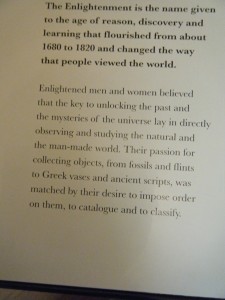
Signage in the Enlightenment room
Our class seems to be throwing around ideas about how British the British Museum really is. I’ll try to give the topic as good a go as the rest of the class has done. I think the British Museum is actually the perfect name for a museum that showcases a country that has borrowed or stolen ideas from other cultures from which they can prosper by showcasing artifacts that they have borrowed or stolen from other cultures from which they prosper. That’s an incredibly wordy way to say that the name fits because Britain itself is a lot like the exhibits the museum has: a forum of borrowed ideas and items. Not convinced? Look around at the people who are at the museum. First off, it’s incredibly crowded. Good luck getting through to see the Rosetta Stone, Cleopatra’s artifacts, the Easter Island statue, or the dancing Shiva. The crowd doesn’t simply consist of British people admiring what they have taken from other cultures. Walk through the crowd and listen to all the different languages that surround you. Chinese, Japanese, Russian, French, something that sounds like Hebrew, and, of course, English- you name it, you’ll probably hear it. Aware of this, the museum offers all of those languages on all of its important postings so that everyone who visits can navigate the museum as easily as possible (which, due to its size, isn’t very possible despite the amounts of maps available for use). As soon as you step out of the museum, you see a hot dog stand and a macadamia nut vendor and feel very much in ‘British’ London. But look around at the surrounding shops and restaurants on surrounding streets. Again, there are multiple Chinese, Thai, Indian, French, and Middle Eastern places all within walking distance (if not eyeshot) of the museum. Not only are these populations present in Britain today but they have also been influential in British history for quite some time. We’ve discussed in group discussions how today’s Britain has been shaped by the colonies it’s imperialized, by the countries it’s traded with. For years, Britain has been formed by borrowing ideas from other countries- it only makes sense that the British Museum would be composed of the work of other countries as well. In that vein, the British Museum is incredibly British in my mind.
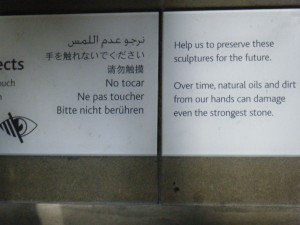
Just some of the languages listed on a sign reminding us not to touch what's on display
So if the museum is British and thus displays the British quite intensely, I’m interested in what the museum wants us to deduce from the exhibits. What does the museum think is British and how does it want to display the culture to us? Clearly, it wants visitors to see a culture that is rich in intellect, has an appreciation for the arts, and is open and proud of its diversity. I would argue that that is in line with what Britain wants to portray itself as to the world: a welcoming place in which diversity can thrive. As our last class discussion demonstrated, the success of that endeavor is debatable to say the least. But the museum at least strives to guide everyone through its walls in as equal a way as is possible by listing so many different languages on its signage. Maybe if we look hard enough, that same helping hand might be around the city as well. Maybe. Just don’t get swept away in the crowd while trying to spot such a sign.
Tags: Audrey · Museums





